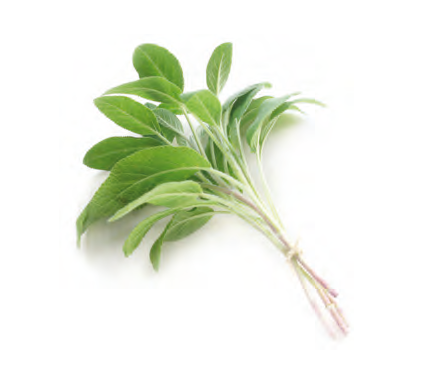Herb of the Month
Sage

Growing
Sage can be started from seed, but it grows very slowly, so you’ll have a while to wait – usually around 15 months – until you can actually use it. The other alternative is a cutting, which should take about three months to establish itself.
If raising from seed, sow indoors in March, or outdoors in April, and then expect to be able to harvest in June of the next year. When it’s grown enough to pot into a larger pot, incorporate plenty of compost or even a little manure into the potting material.
Cuttings should be taken in the spring (5cm long); after three or four years, a plant will start to lose its strength and flavour, so you should expect to reprop-agate from a cutting of the original plant about every three years. It’s fine just to take a cutting from your existing plant: as this grows into a new plant it will become more flavourful again.
Sage needs full sun for at least some of the day, but can tolerate partial shade. A medium soil is best, but in particular it doesn’t want soil that is always moist, as it’s a Mediterranean plant that is drought tolerant. If you look at the leaves, the velvety texture and their slightly padded feel are adaptations to enable the plant to survive without much water when necessary.
Sage likes a little fertiliser a couple of times per summer, and should be pruned back after the flowers die down. It grows very well in a pot.
Culinary uses
Sage is often used to season meat or poultry. It’s good in sausages, and is also often used in stuffing (which can be vegetarian). For vegetarians, it’s good in soups or stews, especially ones with beans or lentils in them, and goes particularly well with squash dishes. It’s best used fresh, but sage leaves keep well in the freezer, and you can also dry it for later use by hanging it in a warm, dry place.
It also goes well with cheese, and baked into biscuits.
Be warned: the flavour is quite strong, so use sage sparingly.
Medicinal uses
Sage tea is good for respiratory infection, nasal congestion, coughs, tonsillitis and sore throats. To prepare, pour boiling water over 1-2 teaspoons of sage leaves, cover, and leave to infuse for ten minutes. Drink one or two cups per day.
Sage tea can also be helpful if you’re suffering from indigestion, and is said to be good for the liver. And it tastes lovely, so you can just drink it for pleasure!
Mixing a little crushed sage with your toothpaste can help to remove plaque and strengthen the gums, as it has an antiseptic effect.
Some studies have shown that sage can improve memory function. There is also some evidence that sage can inhibit the enzyme acetylcholinesterase (AChE); deficiency in AChE is associated with Alzheimer’s. Research is currently underway to investigate whether sage can help people with Alzheimer’s. Sage is known to be well-tolerated, with few side effects, so this is very promising research if it proves to be effective. Meanwhile, increasing the amount of sage in your diet is hardly a hardship!